Network Design, Implementation and Analysis: NIC ASIA Bank
VerifiedAdded on 2022/01/22
|89
|14911
|1497
Report
AI Summary
This report provides a detailed analysis of network types, standards, and their applications within the context of designing and implementing a network infrastructure for a new branch of NIC ASIA Bank. It begins with an executive summary and an introduction to networking concepts, including discussions on LAN, WAN, MAN, peer-to-peer, client-server, and cloud server networks, along with their respective benefits and constraints. The report then delves into network protocols, the OSI and TCP/IP models, and various network standards like BAN and PAN. It explores the impact of network topology, communication, and bandwidth requirements, comparing common networking principles and protocols. Furthermore, the report discusses the operating principles of networking devices, server types, and the inter-dependence of workstation hardware with relevant networking software. The report encompasses server selection, bandwidth deployment, network design, configuration of network services, testing, evaluation, implementation, documentation, and analysis of test results. Finally, it includes a design maintenance schedule and recommendations for potential enhancements, using critical reflection to evaluate the work and the efficient utilization of the networking system.
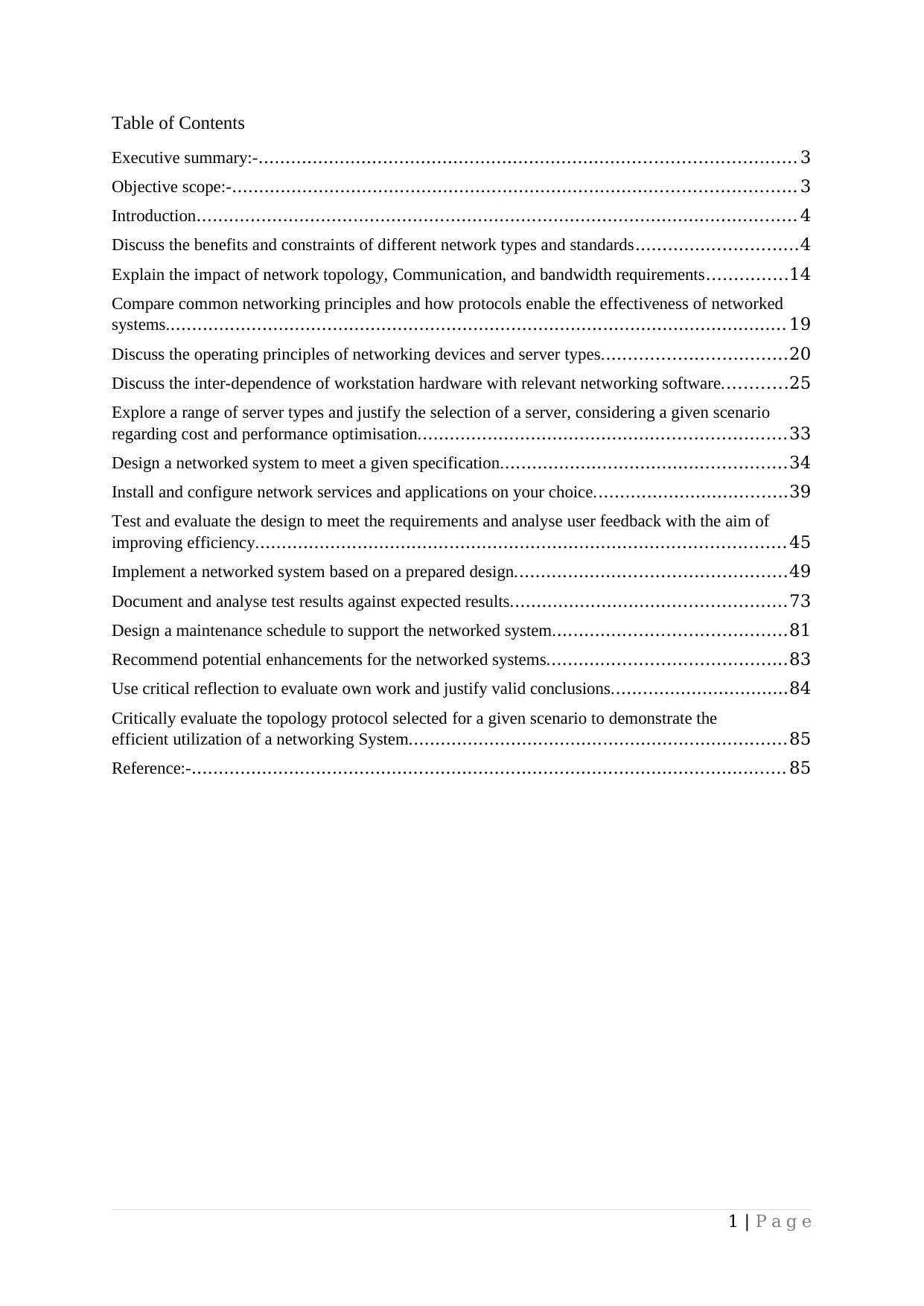
Table of Contents
Executive summary:-................................................................................................... 3
Objective scope:-........................................................................................................ 3
Introduction............................................................................................................... 4
Discuss the benefits and constraints of different network types and standards..............................4
Explain the impact of network topology, Communication, and bandwidth requirements...............14
Compare common networking principles and how protocols enable the effectiveness of networked
systems................................................................................................................... 19
Discuss the operating principles of networking devices and server types..................................20
Discuss the inter-dependence of workstation hardware with relevant networking software............25
Explore a range of server types and justify the selection of a server, considering a given scenario
regarding cost and performance optimisation....................................................................33
Design a networked system to meet a given specification.....................................................34
Install and configure network services and applications on your choice....................................39
Test and evaluate the design to meet the requirements and analyse user feedback with the aim of
improving efficiency.................................................................................................. 45
Implement a networked system based on a prepared design..................................................49
Document and analyse test results against expected results...................................................73
Design a maintenance schedule to support the networked system...........................................81
Recommend potential enhancements for the networked systems............................................83
Use critical reflection to evaluate own work and justify valid conclusions.................................84
Critically evaluate the topology protocol selected for a given scenario to demonstrate the
efficient utilization of a networking System......................................................................85
Reference:-.............................................................................................................. 85
1 | P a g e
Executive summary:-................................................................................................... 3
Objective scope:-........................................................................................................ 3
Introduction............................................................................................................... 4
Discuss the benefits and constraints of different network types and standards..............................4
Explain the impact of network topology, Communication, and bandwidth requirements...............14
Compare common networking principles and how protocols enable the effectiveness of networked
systems................................................................................................................... 19
Discuss the operating principles of networking devices and server types..................................20
Discuss the inter-dependence of workstation hardware with relevant networking software............25
Explore a range of server types and justify the selection of a server, considering a given scenario
regarding cost and performance optimisation....................................................................33
Design a networked system to meet a given specification.....................................................34
Install and configure network services and applications on your choice....................................39
Test and evaluate the design to meet the requirements and analyse user feedback with the aim of
improving efficiency.................................................................................................. 45
Implement a networked system based on a prepared design..................................................49
Document and analyse test results against expected results...................................................73
Design a maintenance schedule to support the networked system...........................................81
Recommend potential enhancements for the networked systems............................................83
Use critical reflection to evaluate own work and justify valid conclusions.................................84
Critically evaluate the topology protocol selected for a given scenario to demonstrate the
efficient utilization of a networking System......................................................................85
Reference:-.............................................................................................................. 85
1 | P a g e
Paraphrase This Document
Need a fresh take? Get an instant paraphrase of this document with our AI Paraphraser
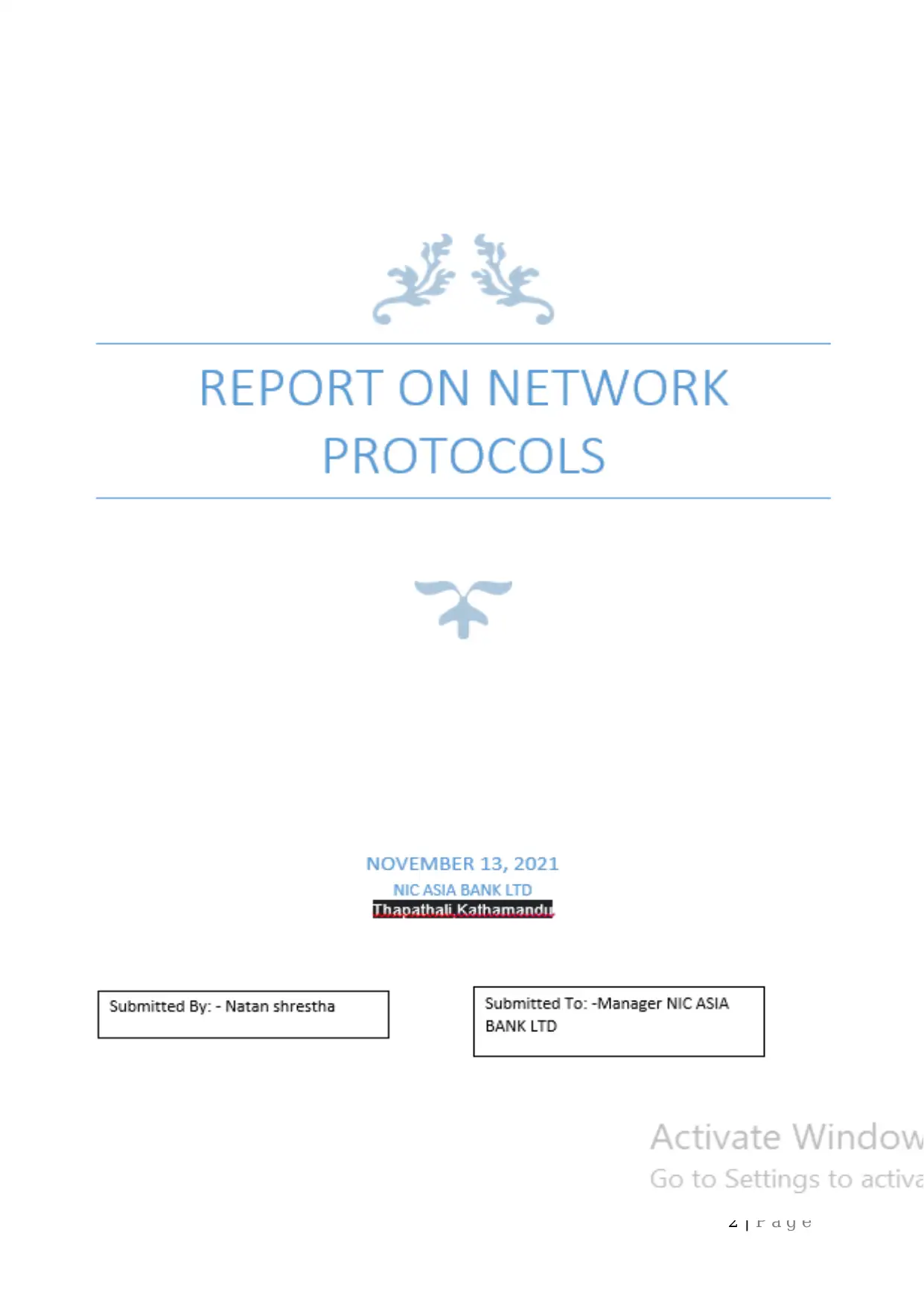
2 | P a g e

3 | P a g e
⊘ This is a preview!⊘
Do you want full access?
Subscribe today to unlock all pages.

Trusted by 1+ million students worldwide

Executive summary:-
Objective scope:-
4 | P a g e
Objective scope:-
4 | P a g e
Paraphrase This Document
Need a fresh take? Get an instant paraphrase of this document with our AI Paraphraser
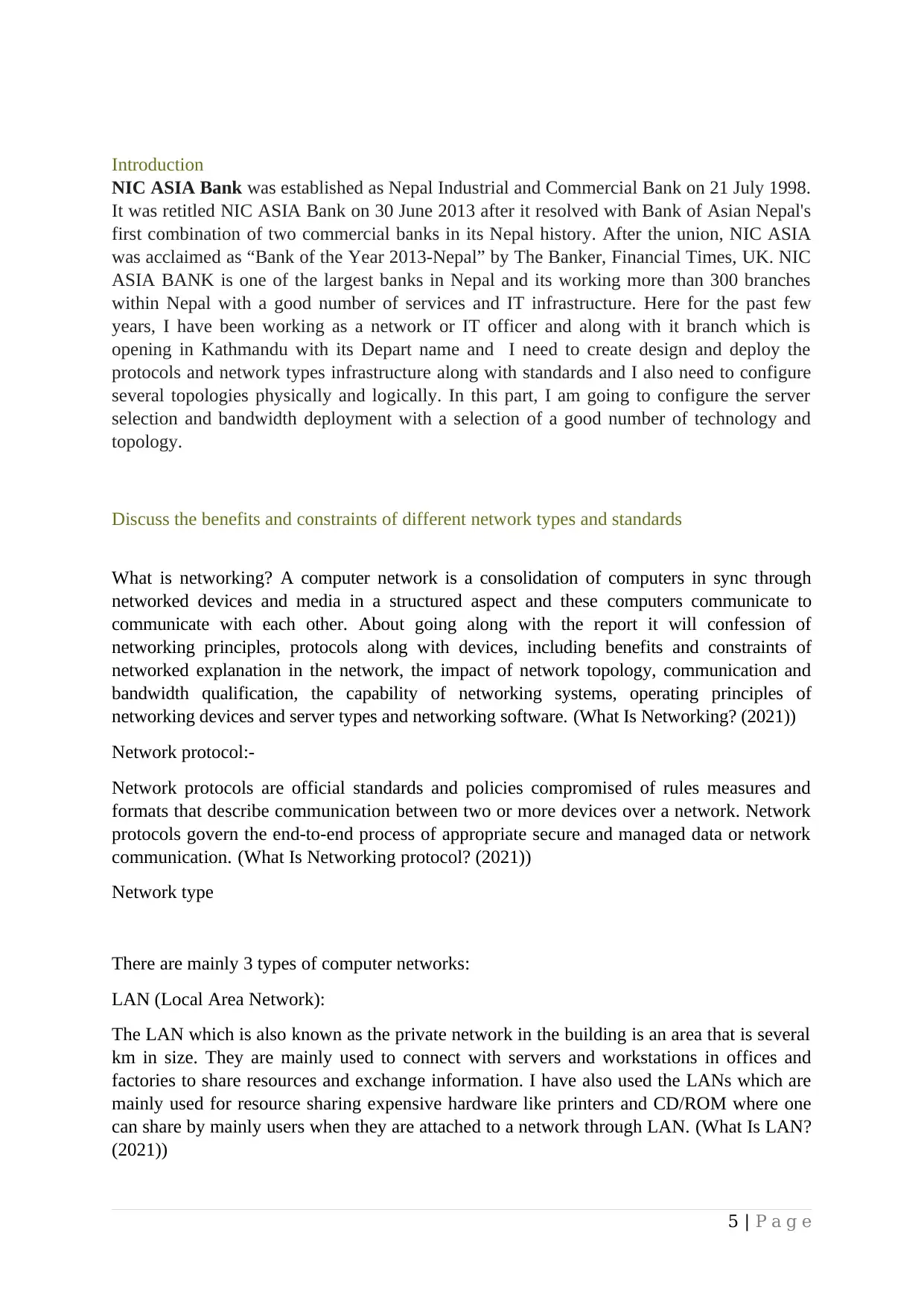
Introduction
NIC ASIA Bank was established as Nepal Industrial and Commercial Bank on 21 July 1998.
It was retitled NIC ASIA Bank on 30 June 2013 after it resolved with Bank of Asian Nepal's
first combination of two commercial banks in its Nepal history. After the union, NIC ASIA
was acclaimed as “Bank of the Year 2013-Nepal” by The Banker, Financial Times, UK. NIC
ASIA BANK is one of the largest banks in Nepal and its working more than 300 branches
within Nepal with a good number of services and IT infrastructure. Here for the past few
years, I have been working as a network or IT officer and along with it branch which is
opening in Kathmandu with its Depart name and I need to create design and deploy the
protocols and network types infrastructure along with standards and I also need to configure
several topologies physically and logically. In this part, I am going to configure the server
selection and bandwidth deployment with a selection of a good number of technology and
topology.
Discuss the benefits and constraints of different network types and standards
What is networking? A computer network is a consolidation of computers in sync through
networked devices and media in a structured aspect and these computers communicate to
communicate with each other. About going along with the report it will confession of
networking principles, protocols along with devices, including benefits and constraints of
networked explanation in the network, the impact of network topology, communication and
bandwidth qualification, the capability of networking systems, operating principles of
networking devices and server types and networking software. (What Is Networking? (2021))
Network protocol:-
Network protocols are official standards and policies compromised of rules measures and
formats that describe communication between two or more devices over a network. Network
protocols govern the end-to-end process of appropriate secure and managed data or network
communication. (What Is Networking protocol? (2021))
Network type
There are mainly 3 types of computer networks:
LAN (Local Area Network):
The LAN which is also known as the private network in the building is an area that is several
km in size. They are mainly used to connect with servers and workstations in offices and
factories to share resources and exchange information. I have also used the LANs which are
mainly used for resource sharing expensive hardware like printers and CD/ROM where one
can share by mainly users when they are attached to a network through LAN. (What Is LAN?
(2021))
5 | P a g e
NIC ASIA Bank was established as Nepal Industrial and Commercial Bank on 21 July 1998.
It was retitled NIC ASIA Bank on 30 June 2013 after it resolved with Bank of Asian Nepal's
first combination of two commercial banks in its Nepal history. After the union, NIC ASIA
was acclaimed as “Bank of the Year 2013-Nepal” by The Banker, Financial Times, UK. NIC
ASIA BANK is one of the largest banks in Nepal and its working more than 300 branches
within Nepal with a good number of services and IT infrastructure. Here for the past few
years, I have been working as a network or IT officer and along with it branch which is
opening in Kathmandu with its Depart name and I need to create design and deploy the
protocols and network types infrastructure along with standards and I also need to configure
several topologies physically and logically. In this part, I am going to configure the server
selection and bandwidth deployment with a selection of a good number of technology and
topology.
Discuss the benefits and constraints of different network types and standards
What is networking? A computer network is a consolidation of computers in sync through
networked devices and media in a structured aspect and these computers communicate to
communicate with each other. About going along with the report it will confession of
networking principles, protocols along with devices, including benefits and constraints of
networked explanation in the network, the impact of network topology, communication and
bandwidth qualification, the capability of networking systems, operating principles of
networking devices and server types and networking software. (What Is Networking? (2021))
Network protocol:-
Network protocols are official standards and policies compromised of rules measures and
formats that describe communication between two or more devices over a network. Network
protocols govern the end-to-end process of appropriate secure and managed data or network
communication. (What Is Networking protocol? (2021))
Network type
There are mainly 3 types of computer networks:
LAN (Local Area Network):
The LAN which is also known as the private network in the building is an area that is several
km in size. They are mainly used to connect with servers and workstations in offices and
factories to share resources and exchange information. I have also used the LANs which are
mainly used for resource sharing expensive hardware like printers and CD/ROM where one
can share by mainly users when they are attached to a network through LAN. (What Is LAN?
(2021))
5 | P a g e
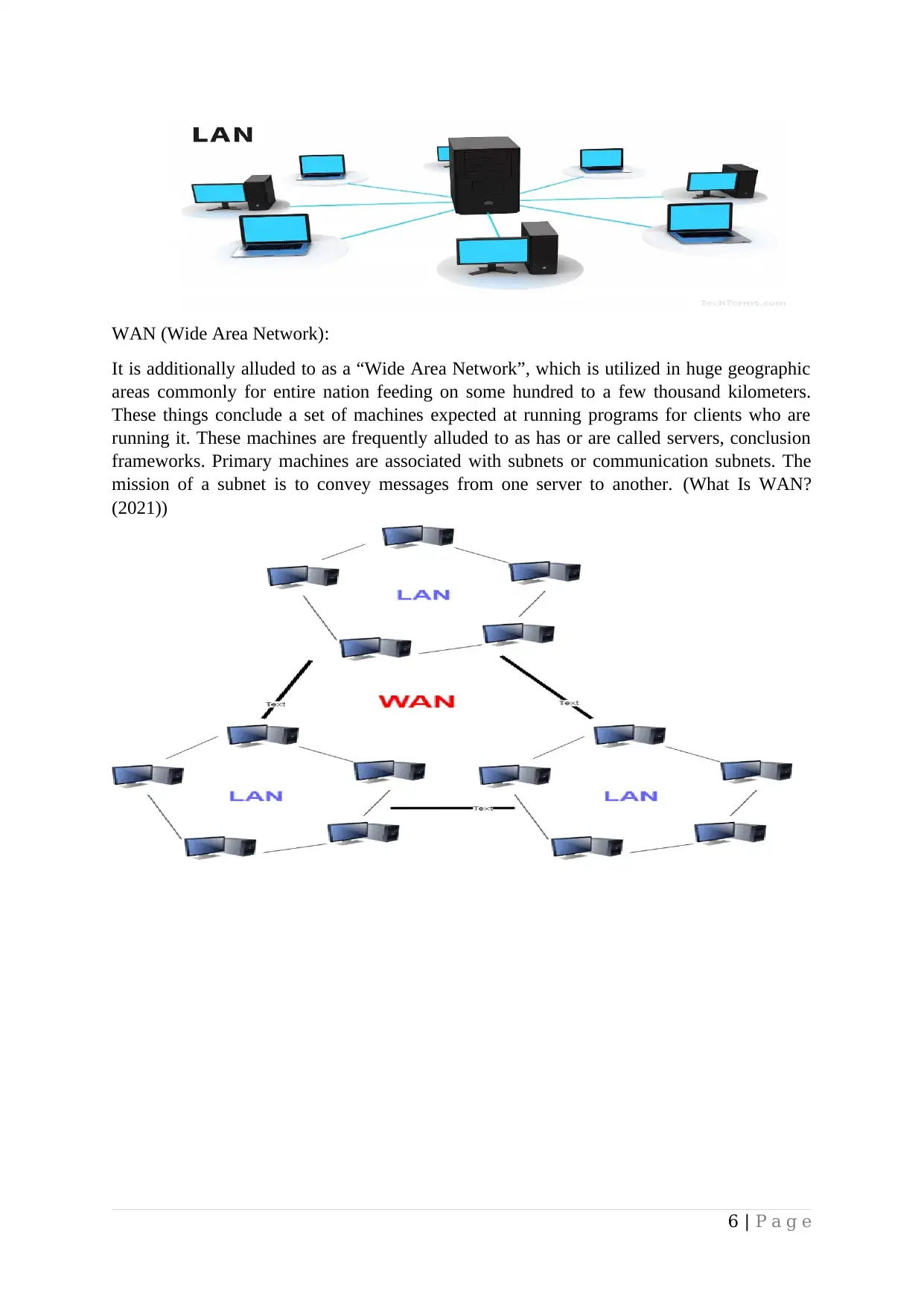
WAN (Wide Area Network):
It is additionally alluded to as a “Wide Area Network”, which is utilized in huge geographic
areas commonly for entire nation feeding on some hundred to a few thousand kilometers.
These things conclude a set of machines expected at running programs for clients who are
running it. These machines are frequently alluded to as has or are called servers, conclusion
frameworks. Primary machines are associated with subnets or communication subnets. The
mission of a subnet is to convey messages from one server to another. (What Is WAN?
(2021))
6 | P a g e
It is additionally alluded to as a “Wide Area Network”, which is utilized in huge geographic
areas commonly for entire nation feeding on some hundred to a few thousand kilometers.
These things conclude a set of machines expected at running programs for clients who are
running it. These machines are frequently alluded to as has or are called servers, conclusion
frameworks. Primary machines are associated with subnets or communication subnets. The
mission of a subnet is to convey messages from one server to another. (What Is WAN?
(2021))
6 | P a g e
⊘ This is a preview!⊘
Do you want full access?
Subscribe today to unlock all pages.

Trusted by 1+ million students worldwide
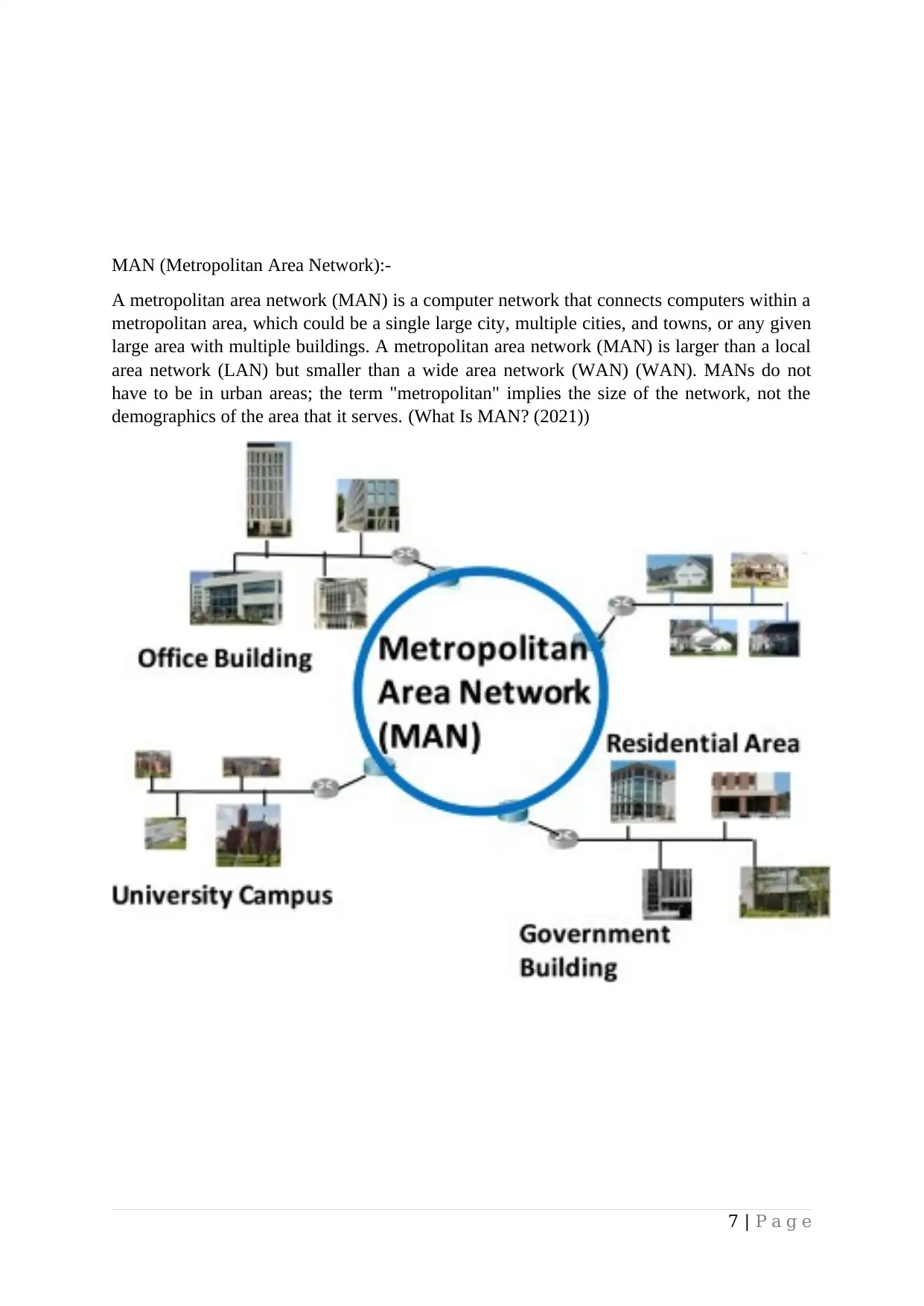
MAN (Metropolitan Area Network):-
A metropolitan area network (MAN) is a computer network that connects computers within a
metropolitan area, which could be a single large city, multiple cities, and towns, or any given
large area with multiple buildings. A metropolitan area network (MAN) is larger than a local
area network (LAN) but smaller than a wide area network (WAN) (WAN). MANs do not
have to be in urban areas; the term "metropolitan" implies the size of the network, not the
demographics of the area that it serves. (What Is MAN? (2021))
7 | P a g e
A metropolitan area network (MAN) is a computer network that connects computers within a
metropolitan area, which could be a single large city, multiple cities, and towns, or any given
large area with multiple buildings. A metropolitan area network (MAN) is larger than a local
area network (LAN) but smaller than a wide area network (WAN) (WAN). MANs do not
have to be in urban areas; the term "metropolitan" implies the size of the network, not the
demographics of the area that it serves. (What Is MAN? (2021))
7 | P a g e
Paraphrase This Document
Need a fresh take? Get an instant paraphrase of this document with our AI Paraphraser
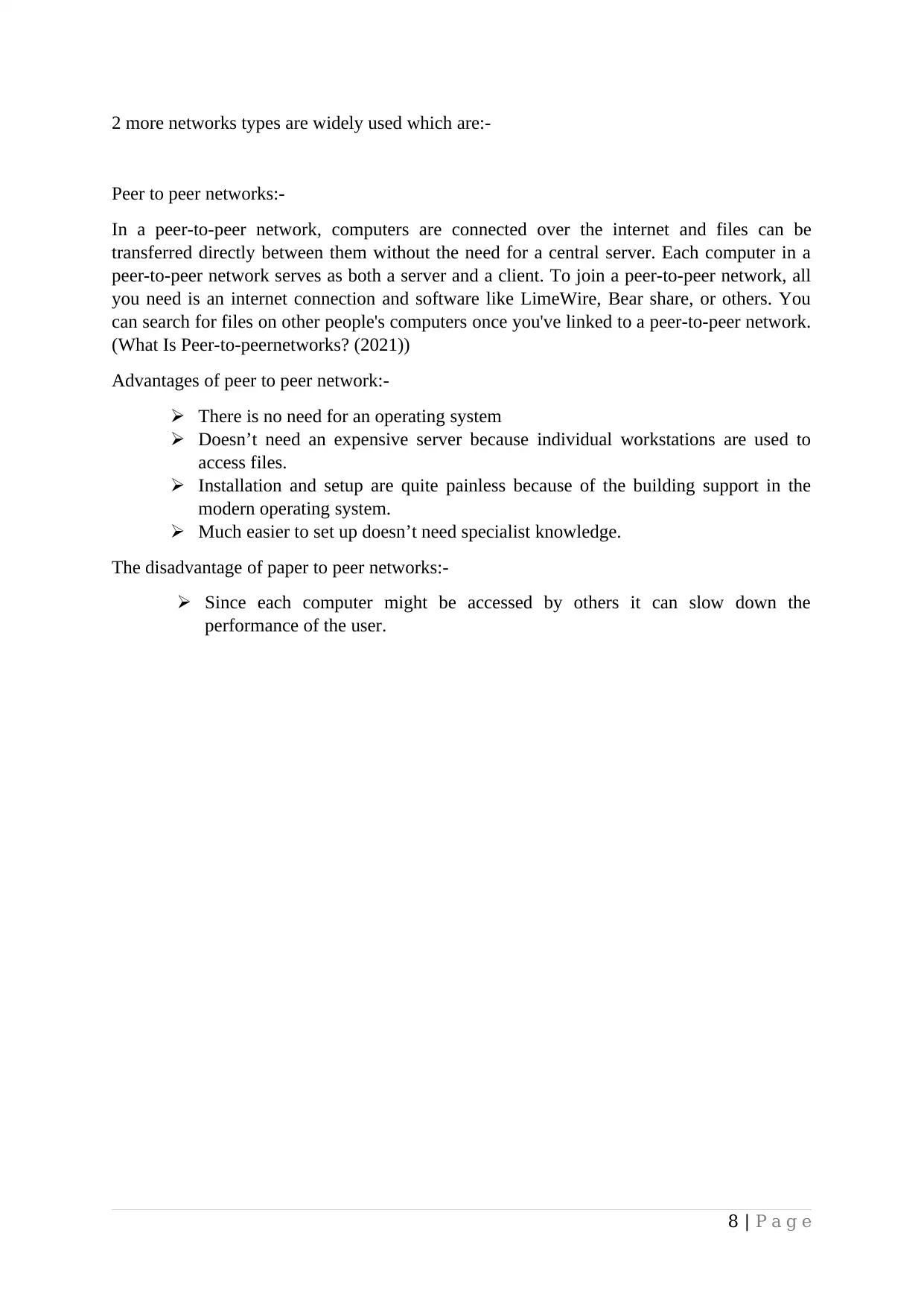
2 more networks types are widely used which are:-
Peer to peer networks:-
In a peer-to-peer network, computers are connected over the internet and files can be
transferred directly between them without the need for a central server. Each computer in a
peer-to-peer network serves as both a server and a client. To join a peer-to-peer network, all
you need is an internet connection and software like LimeWire, Bear share, or others. You
can search for files on other people's computers once you've linked to a peer-to-peer network.
(What Is Peer-to-peernetworks? (2021))
Advantages of peer to peer network:-
There is no need for an operating system
Doesn’t need an expensive server because individual workstations are used to
access files.
Installation and setup are quite painless because of the building support in the
modern operating system.
Much easier to set up doesn’t need specialist knowledge.
The disadvantage of paper to peer networks:-
Since each computer might be accessed by others it can slow down the
performance of the user.
8 | P a g e
Peer to peer networks:-
In a peer-to-peer network, computers are connected over the internet and files can be
transferred directly between them without the need for a central server. Each computer in a
peer-to-peer network serves as both a server and a client. To join a peer-to-peer network, all
you need is an internet connection and software like LimeWire, Bear share, or others. You
can search for files on other people's computers once you've linked to a peer-to-peer network.
(What Is Peer-to-peernetworks? (2021))
Advantages of peer to peer network:-
There is no need for an operating system
Doesn’t need an expensive server because individual workstations are used to
access files.
Installation and setup are quite painless because of the building support in the
modern operating system.
Much easier to set up doesn’t need specialist knowledge.
The disadvantage of paper to peer networks:-
Since each computer might be accessed by others it can slow down the
performance of the user.
8 | P a g e
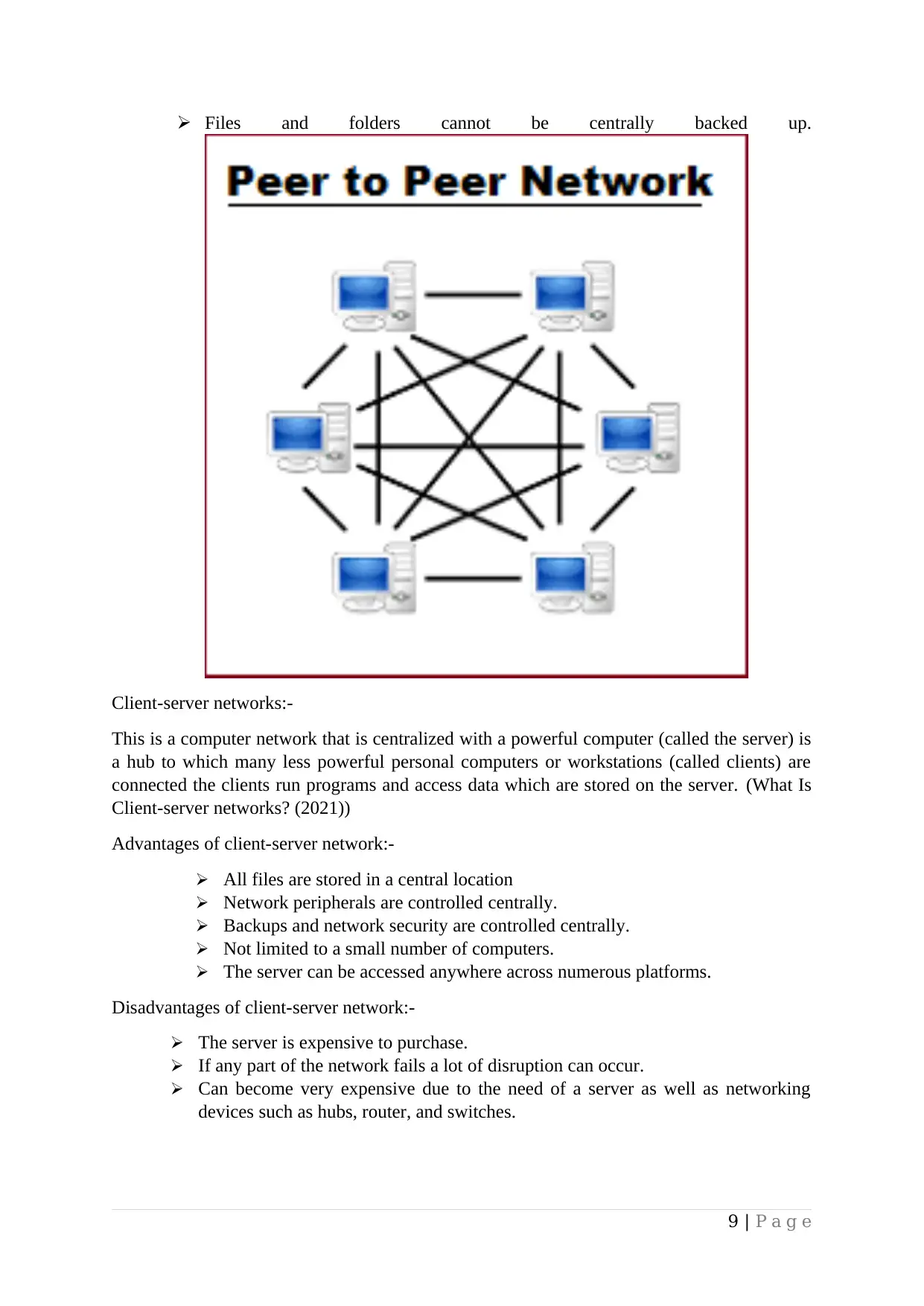
Files and folders cannot be centrally backed up.
Client-server networks:-
This is a computer network that is centralized with a powerful computer (called the server) is
a hub to which many less powerful personal computers or workstations (called clients) are
connected the clients run programs and access data which are stored on the server. (What Is
Client-server networks? (2021))
Advantages of client-server network:-
All files are stored in a central location
Network peripherals are controlled centrally.
Backups and network security are controlled centrally.
Not limited to a small number of computers.
The server can be accessed anywhere across numerous platforms.
Disadvantages of client-server network:-
The server is expensive to purchase.
If any part of the network fails a lot of disruption can occur.
Can become very expensive due to the need of a server as well as networking
devices such as hubs, router, and switches.
9 | P a g e
Client-server networks:-
This is a computer network that is centralized with a powerful computer (called the server) is
a hub to which many less powerful personal computers or workstations (called clients) are
connected the clients run programs and access data which are stored on the server. (What Is
Client-server networks? (2021))
Advantages of client-server network:-
All files are stored in a central location
Network peripherals are controlled centrally.
Backups and network security are controlled centrally.
Not limited to a small number of computers.
The server can be accessed anywhere across numerous platforms.
Disadvantages of client-server network:-
The server is expensive to purchase.
If any part of the network fails a lot of disruption can occur.
Can become very expensive due to the need of a server as well as networking
devices such as hubs, router, and switches.
9 | P a g e
⊘ This is a preview!⊘
Do you want full access?
Subscribe today to unlock all pages.

Trusted by 1+ million students worldwide
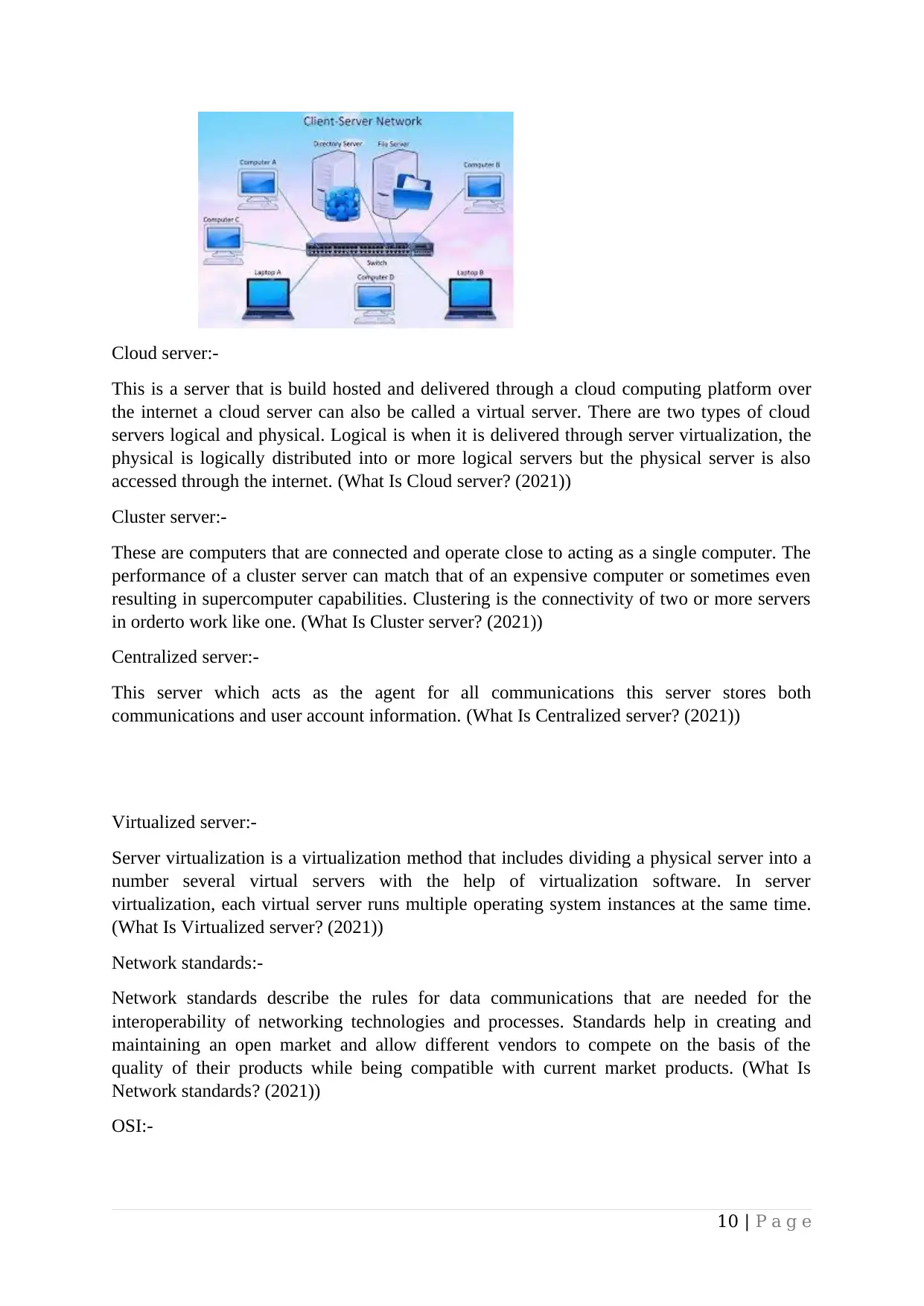
Cloud server:-
This is a server that is build hosted and delivered through a cloud computing platform over
the internet a cloud server can also be called a virtual server. There are two types of cloud
servers logical and physical. Logical is when it is delivered through server virtualization, the
physical is logically distributed into or more logical servers but the physical server is also
accessed through the internet. (What Is Cloud server? (2021))
Cluster server:-
These are computers that are connected and operate close to acting as a single computer. The
performance of a cluster server can match that of an expensive computer or sometimes even
resulting in supercomputer capabilities. Clustering is the connectivity of two or more servers
in orderto work like one. (What Is Cluster server? (2021))
Centralized server:-
This server which acts as the agent for all communications this server stores both
communications and user account information. (What Is Centralized server? (2021))
Virtualized server:-
Server virtualization is a virtualization method that includes dividing a physical server into a
number several virtual servers with the help of virtualization software. In server
virtualization, each virtual server runs multiple operating system instances at the same time.
(What Is Virtualized server? (2021))
Network standards:-
Network standards describe the rules for data communications that are needed for the
interoperability of networking technologies and processes. Standards help in creating and
maintaining an open market and allow different vendors to compete on the basis of the
quality of their products while being compatible with current market products. (What Is
Network standards? (2021))
OSI:-
10 | P a g e
This is a server that is build hosted and delivered through a cloud computing platform over
the internet a cloud server can also be called a virtual server. There are two types of cloud
servers logical and physical. Logical is when it is delivered through server virtualization, the
physical is logically distributed into or more logical servers but the physical server is also
accessed through the internet. (What Is Cloud server? (2021))
Cluster server:-
These are computers that are connected and operate close to acting as a single computer. The
performance of a cluster server can match that of an expensive computer or sometimes even
resulting in supercomputer capabilities. Clustering is the connectivity of two or more servers
in orderto work like one. (What Is Cluster server? (2021))
Centralized server:-
This server which acts as the agent for all communications this server stores both
communications and user account information. (What Is Centralized server? (2021))
Virtualized server:-
Server virtualization is a virtualization method that includes dividing a physical server into a
number several virtual servers with the help of virtualization software. In server
virtualization, each virtual server runs multiple operating system instances at the same time.
(What Is Virtualized server? (2021))
Network standards:-
Network standards describe the rules for data communications that are needed for the
interoperability of networking technologies and processes. Standards help in creating and
maintaining an open market and allow different vendors to compete on the basis of the
quality of their products while being compatible with current market products. (What Is
Network standards? (2021))
OSI:-
10 | P a g e
Paraphrase This Document
Need a fresh take? Get an instant paraphrase of this document with our AI Paraphraser
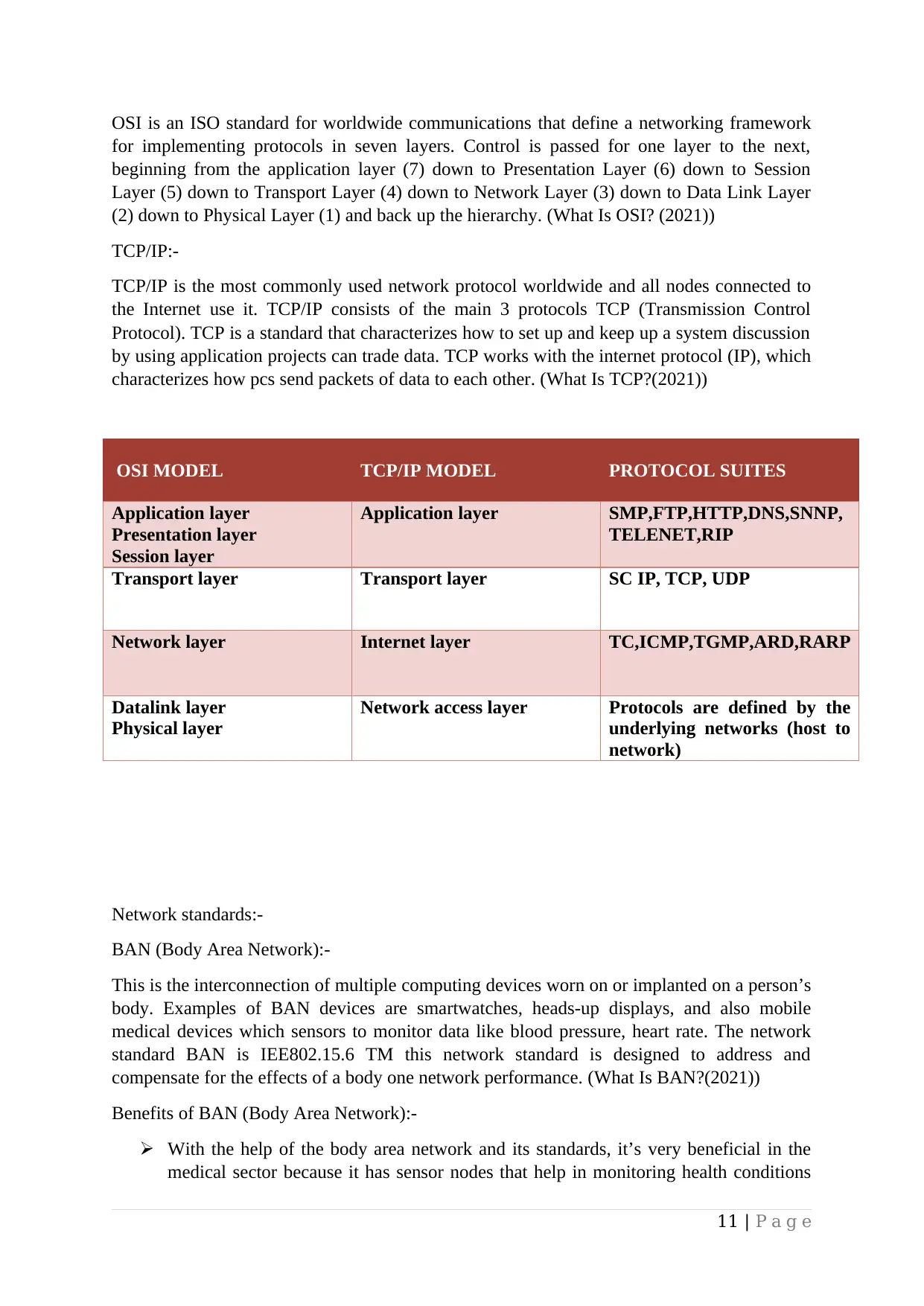
OSI is an ISO standard for worldwide communications that define a networking framework
for implementing protocols in seven layers. Control is passed for one layer to the next,
beginning from the application layer (7) down to Presentation Layer (6) down to Session
Layer (5) down to Transport Layer (4) down to Network Layer (3) down to Data Link Layer
(2) down to Physical Layer (1) and back up the hierarchy. (What Is OSI? (2021))
TCP/IP:-
TCP/IP is the most commonly used network protocol worldwide and all nodes connected to
the Internet use it. TCP/IP consists of the main 3 protocols TCP (Transmission Control
Protocol). TCP is a standard that characterizes how to set up and keep up a system discussion
by using application projects can trade data. TCP works with the internet protocol (IP), which
characterizes how pcs send packets of data to each other. (What Is TCP?(2021))
OSI MODEL TCP/IP MODEL PROTOCOL SUITES
Application layer
Presentation layer
Session layer
Application layer SMP,FTP,HTTP,DNS,SNNP,
TELENET,RIP
Transport layer Transport layer SC IP, TCP, UDP
Network layer Internet layer TC,ICMP,TGMP,ARD,RARP
Datalink layer
Physical layer
Network access layer Protocols are defined by the
underlying networks (host to
network)
Network standards:-
BAN (Body Area Network):-
This is the interconnection of multiple computing devices worn on or implanted on a person’s
body. Examples of BAN devices are smartwatches, heads-up displays, and also mobile
medical devices which sensors to monitor data like blood pressure, heart rate. The network
standard BAN is IEE802.15.6 TM this network standard is designed to address and
compensate for the effects of a body one network performance. (What Is BAN?(2021))
Benefits of BAN (Body Area Network):-
With the help of the body area network and its standards, it’s very beneficial in the
medical sector because it has sensor nodes that help in monitoring health conditions
11 | P a g e
for implementing protocols in seven layers. Control is passed for one layer to the next,
beginning from the application layer (7) down to Presentation Layer (6) down to Session
Layer (5) down to Transport Layer (4) down to Network Layer (3) down to Data Link Layer
(2) down to Physical Layer (1) and back up the hierarchy. (What Is OSI? (2021))
TCP/IP:-
TCP/IP is the most commonly used network protocol worldwide and all nodes connected to
the Internet use it. TCP/IP consists of the main 3 protocols TCP (Transmission Control
Protocol). TCP is a standard that characterizes how to set up and keep up a system discussion
by using application projects can trade data. TCP works with the internet protocol (IP), which
characterizes how pcs send packets of data to each other. (What Is TCP?(2021))
OSI MODEL TCP/IP MODEL PROTOCOL SUITES
Application layer
Presentation layer
Session layer
Application layer SMP,FTP,HTTP,DNS,SNNP,
TELENET,RIP
Transport layer Transport layer SC IP, TCP, UDP
Network layer Internet layer TC,ICMP,TGMP,ARD,RARP
Datalink layer
Physical layer
Network access layer Protocols are defined by the
underlying networks (host to
network)
Network standards:-
BAN (Body Area Network):-
This is the interconnection of multiple computing devices worn on or implanted on a person’s
body. Examples of BAN devices are smartwatches, heads-up displays, and also mobile
medical devices which sensors to monitor data like blood pressure, heart rate. The network
standard BAN is IEE802.15.6 TM this network standard is designed to address and
compensate for the effects of a body one network performance. (What Is BAN?(2021))
Benefits of BAN (Body Area Network):-
With the help of the body area network and its standards, it’s very beneficial in the
medical sector because it has sensor nodes that help in monitoring health conditions
11 | P a g e
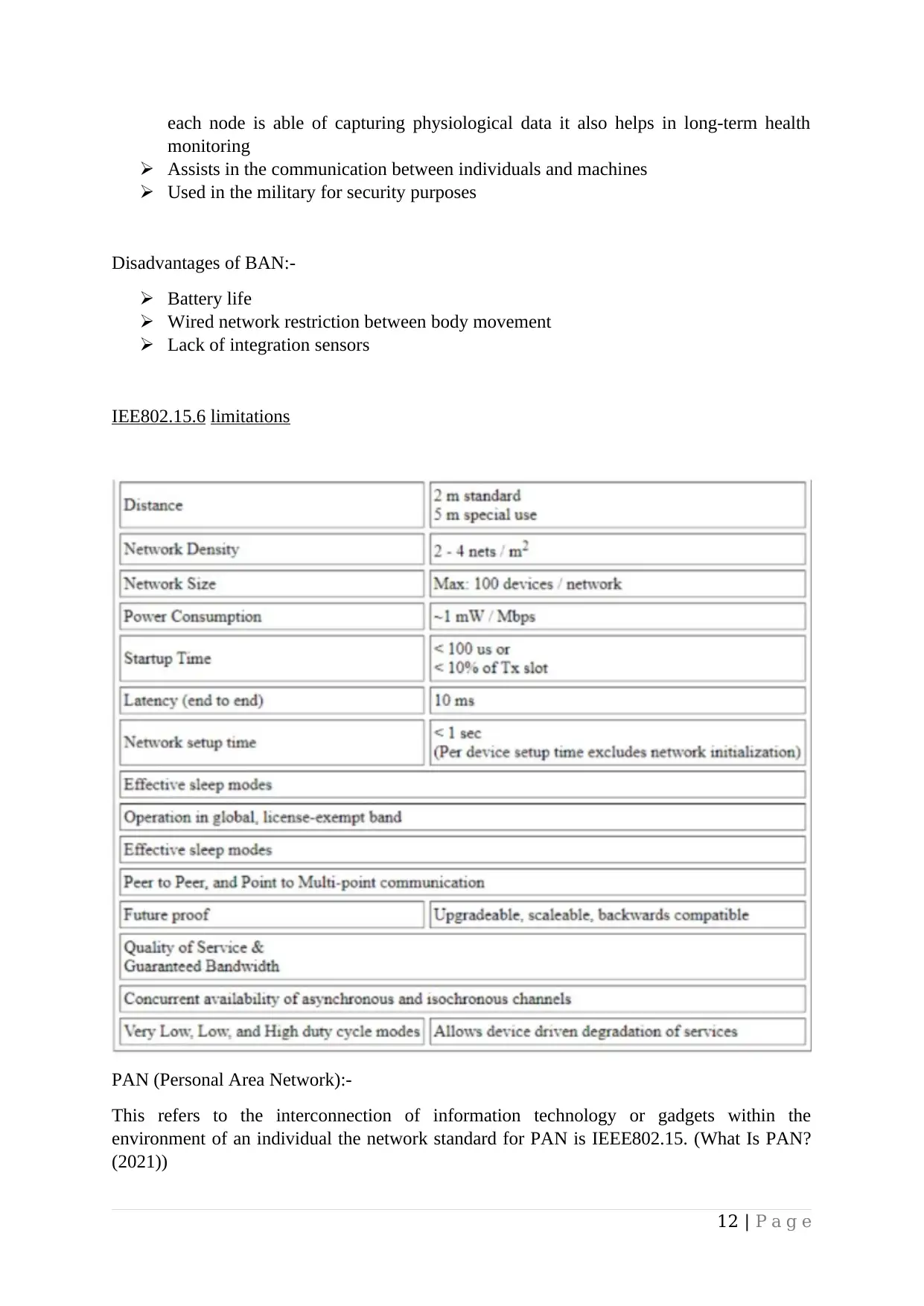
each node is able of capturing physiological data it also helps in long-term health
monitoring
Assists in the communication between individuals and machines
Used in the military for security purposes
Disadvantages of BAN:-
Battery life
Wired network restriction between body movement
Lack of integration sensors
IEE802.15.6 limitations
PAN (Personal Area Network):-
This refers to the interconnection of information technology or gadgets within the
environment of an individual the network standard for PAN is IEEE802.15. (What Is PAN?
(2021))
12 | P a g e
monitoring
Assists in the communication between individuals and machines
Used in the military for security purposes
Disadvantages of BAN:-
Battery life
Wired network restriction between body movement
Lack of integration sensors
IEE802.15.6 limitations
PAN (Personal Area Network):-
This refers to the interconnection of information technology or gadgets within the
environment of an individual the network standard for PAN is IEEE802.15. (What Is PAN?
(2021))
12 | P a g e
⊘ This is a preview!⊘
Do you want full access?
Subscribe today to unlock all pages.

Trusted by 1+ million students worldwide
1 out of 89
Related Documents
Your All-in-One AI-Powered Toolkit for Academic Success.
+13062052269
info@desklib.com
Available 24*7 on WhatsApp / Email
![[object Object]](/_next/static/media/star-bottom.7253800d.svg)
Unlock your academic potential
Copyright © 2020–2025 A2Z Services. All Rights Reserved. Developed and managed by ZUCOL.



